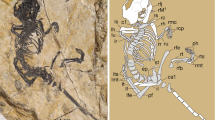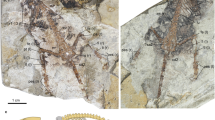Abstract
Few fossils show the incipient stages of complex morphological transformations1. For example, the earliest stages in the remodelling of the spiracular tract and suspensorium (jaw suspension) of osteolepiform fishes2,3,4 into the middle ear of tetrapods have remained elusive3. The most primitive known tetrapods show a middle ear architecture that is very different from osteolepiforms such as Eusthenopteron3, with little indication of how this transformation took place. Here we present an analysis of tetrapod middle ear origins that is based on a detailed study of Panderichthys, the immediate sister taxon of tetrapods. We show that the spiracular region is radically transformed from osteolepiforms and represents the earliest stages in the origin of the tetrapod middle ear architecture. The posterior palatoquadrate of Panderichthys is completely tetrapod-like and defines a similarly tetrapod-like spiracular tract. The hyomandibula has lost its distal portion, representing a previously unrecognized advance towards a stapes-like morphology. This spiracular specialization suggests that the middle ear of early tetrapods evolved initially as part of a spiracular breathing apparatus5,6.
This is a preview of subscription content, access via your institution
Access options
Subscribe to this journal
Receive 51 print issues and online access
$199.00 per year
only $3.90 per issue
Buy this article
- Purchase on Springer Link
- Instant access to full article PDF
Prices may be subject to local taxes which are calculated during checkout




Similar content being viewed by others
References
Carroll, R. L. Patterns and Processes of Vertebrate Evolution (Cambridge Univ. Press, Cambridge, 1997)
Carroll, R. L. in The Terrestrial Environment and the Origin of Land Vertebrates (ed. Panchen, A. L.) 293–317 (Academic, London, 1980)
Clack, J. A. Patterns and processes in the early evolution of the tetrapod ear. J. Neurobiol. 53, 251–264 (2002)
Clack, J. A. Earliest known tetrapod braincase and the evolution of the stapes and fenestra ovalis. Nature 369, 392–394 (1994)
Panchen, A. L. On the amphibian Crassigyrinus scoticus Watson from the Carboniferous of Scotland. Phil. Trans. R. Soc. Lond. B 309, 505–568 (1985)
Clack, J. A. Discovery of the earliest-known tetrapod stapes. Nature 342, 425–427 (1989)
Ahlberg, P. E. & Johanson, Z. Osteolepiforms and the ancestry of tetrapods. Nature 395, 792–794 (1998)
Ahlberg, P. E. A re-examination of sarcopterygian interrelationships, with special reference to the Porolepiformes. Zool. J. Linn. Soc. 103, 241–287 (1991)
Jarvik, E. On the visceral skeleton in Eusthenopteron with a discussion of the parasphenoid and palatoquadrate in fishes. Kungl. Svenska Vetenskakad. Handl. 5, 1–104 (1954)
Long, J. A., Barwick, R. E. & Campbell, K. S. W. Osteology and functional morphology of the osteolepiform fish Gogonasus andrewsae Long, 1985, from the Upper Devonian Gogo Formation, Western Australia. Rec. West. Aust. Mus. 53 (suppl.), 1–89 (1997)
Lebedev, O. A. Morphology of a new osteolepidid fish from Russia. Bull. Mus. Natl Hist. Nat. C 17, 287–341 (1995)
Jarvik, E. Middle and Upper Devonian Porolepiformes form East Greenland with special reference to Glyptolepis groenlandica n. sp. Meddelelser Grønland 187, 1–307 (1972)
Gardiner, B. G. The relationships of the palaeoniscoid fishes, a review based on new specimens of Mimia and Moythomasia from the Upper Devonian of Western Australia. Bull. Brit. Mus. (Nat. Hist.) Geol. 37, 173–428 (1984)
Clack, J. A. Acanthostega gunnari, a Devonian tetrapod from Greenland; the snout, palate and ventral parts of the braincase, with a discussion of their significance. Meddelelser Grønland Geosci. 31, 1–24 (1994)
Westoll, T. S. The origin of the tetrapods. Biol. Rev. 18, 78–98 (1943)
Rosen, D. E., Forey, P. L., Gardiner, B. G. & Patterson, C. Lungfishes, tetrapods, paleontology, and plesiomorphy. Bull. Am. Mus. Nat. Hist. 167, 159–276 (1981)
Vorobyeva, E. & Schultze, H.-P. in Origins of the Higher Groups of Tetrapods: Controversy and Consensus (eds Schultze, H.-P. & Trueb, L.) 68–109 (Cornell Univ. Press (Canstock), Ithaca, NY, 1991)
Ahlberg, P. E., Clack, J. A. & Luksevics, E. Rapid braincase evolution between Panderichthys and the earliest tetrapods. Nature 381, 61–64 (1996)
Clack, J. A. The neurocranium of Acanthostega gunnari Jarvik and the evolution of the otic region in tetrapods. Zool. J. Linn. Soc. 122, 61–97 (1998)
Ahlberg, P. E., Luksevics, E. & Lebedev, O. The first tetrapod finds from the Devonian (Upper Famennian) of Latvia. Phil. Trans. R. Soc. Lond. B 343, 303–328 (1994)
Smithson, T. R. & Thomson, K. S. The hyomandibula of Eusthenopteron foordi Whiteaves (Pisces: Crossopterygii) and the early evolution of the tetrapod stapes. Zool. J. Linn. Soc. 74, 93–103 (1982)
Clack, J. A. Gaining Ground: The Origin and Evolution of Tetrapods (ed. Farlow, J. O.) (Indiana Univ. Press, Bloomington, IN, 2002)
Rand, H. W. The functions of the spiracle of the skate. Am. Nat. 41, 287–302 (1907)
Summers, A. P. & Ferry-Graham, L. A. Ventilatory modes and mechanics of the hedgehog skate (Leucoraja erinacea): testing the continuous flow model. J. Exp. Biol. 204, 1577–1587 (2001)
Clack, J. A. et al. A uniquely specialized ear in a very early tetrapod. Nature 425, 65–69 (2003)
Jarvik, E. Basic Structure and Evolution of Vertebrates (Academic, London, 1980)
Acknowledgements
We thank E. Luksevics and I. Zupins for access to specimens; T. Rowe for computed tomography scan work; M. Arsenault and S. Desbiens for providing the Eusthenopteron specimen and, together with T. Rowe, for allowing us to publish these early results. M.D.B is supported by a Fonds québecois de la recherche sur la nature et les technologies (FQRNT) bourse de maîtrise (graduate scholarship). P.E.A. is supported by a professorship and research grant from Vetenskapsrådet.
Author information
Authors and Affiliations
Corresponding author
Ethics declarations
Competing interests
Reprints and permissions information is available at npg.nature.com/reprintsandpermissions. The authors declare no competing financial interests.
Supplementary information
Supplementary Notes
This contains an additional description of the Panderichthys specimen from this work. (DOC 22 kb)
Rights and permissions
About this article
Cite this article
Brazeau, M., Ahlberg, P. Tetrapod-like middle ear architecture in a Devonian fish. Nature 439, 318–321 (2006). https://doi.org/10.1038/nature04196
Received:
Accepted:
Issue Date:
DOI: https://doi.org/10.1038/nature04196
This article is cited by
-
Elpistostege and the origin of the vertebrate hand
Nature (2020)
-
A symmoriiform from the Late Devonian of Morocco demonstrates a derived jaw function in ancient chondrichthyans
Communications Biology (2020)
-
Morphology of the earliest reconstructable tetrapod Parmastega aelidae
Nature (2019)
-
Animals and ICE: meaning, origin, and diversity
Biological Cybernetics (2016)
-
Spiracular air breathing in polypterid fishes and its implications for aerial respiration in stem tetrapods
Nature Communications (2014)
Comments
By submitting a comment you agree to abide by our Terms and Community Guidelines. If you find something abusive or that does not comply with our terms or guidelines please flag it as inappropriate.



